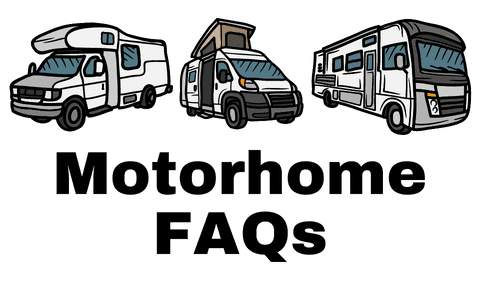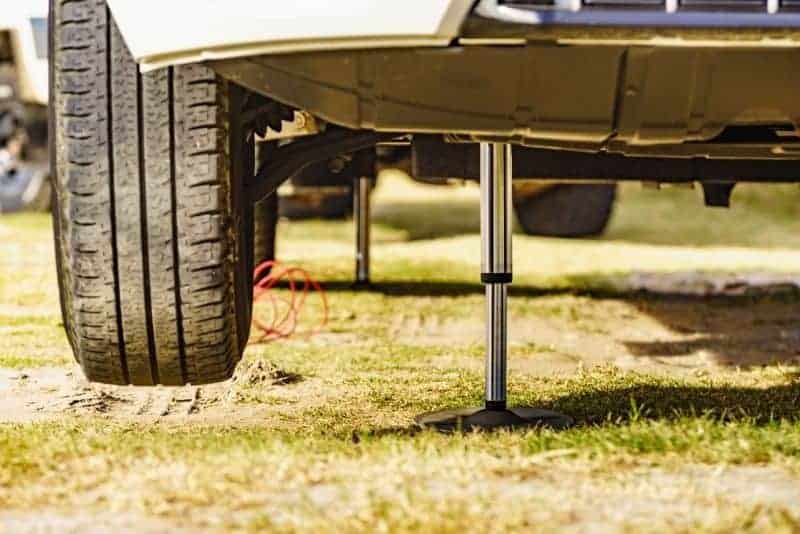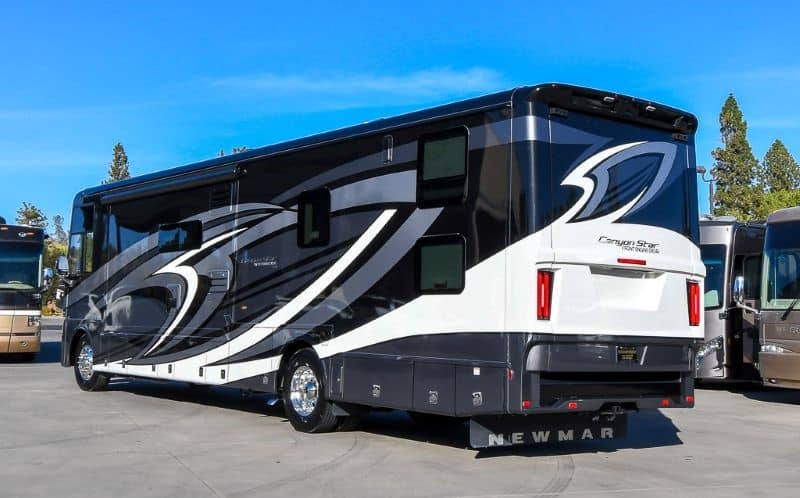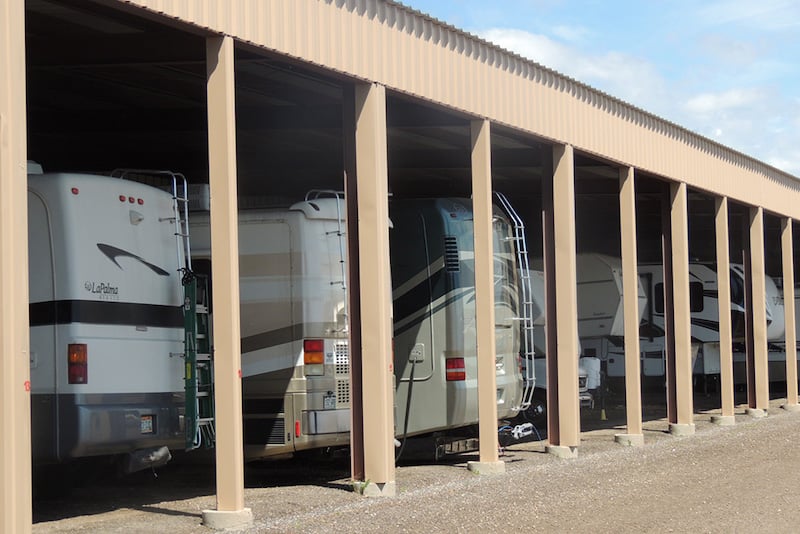Most Class A motorhomes and some Class C RVs have RV auto levelers. In our travels, we have noticed many auto-leveled RVs with their tires off the ground. So it made us wonder: should your RV tires be off the ground when auto-leveling?
Leveling your RV when you get to a campsite is essential not only for your comfort but for protecting your RV from costly damage as well. But, the process of leveling manually can be a bit of a pain. Thankfully, modern technology has just the solution: RV auto levelers.
These handy devices get your RV perfectly level in moments at just the push of a button. But, as easy and convenient as auto levelers are, people still have questions about them. For example, should RV tires be off the ground when auto-leveling?
Today, we’ll take a closer look at RV auto levelers and answer just that question, plus many others you might have. Let’s get into it.
What Are RV Auto Levelers?
For much of RV history, RV’s had to be leveled manually. This required using things like Andersen levelers, blocks, and adjusting jacks. You’d typically need to check your progress with a level, and overall, leveling can take a while.
With RV auto levelers, the whole process is much easier. You might even say they’re the best thing to happen to RVs since air conditioning.
RV auto levelers level your RV at the push of a button. The leveling system will automatically measure when the RV is perfectly level, taking out any guesswork and saving you a lot of time. The whole process takes no more than a few minutes.
Do All RVs Have Auto Levelers?
While RV auto levelers are popular, they’re far from universal. Not all RVs have auto levelers, and it’s still very common to find RVs without them.
In many cases, RV auto levelers are available as an optional add-on when buying an RV. So, even if it’s not included as standard, it is available as an upcharge.
But, some types of RVs do commonly include auto levelers as a standard option. These tend to be motorhomes and fifth wheels, particularly at the higher end. Because these are particularly large and expensive RVs, an auto-leveling system is well worth it.
Should RV Tires Be Off The Ground When Auto Leveling?
A common question in the RV world is whether RV tires should be off the ground when leveling.
The general consensus here is no. Your RV tires should not be off the ground when auto-leveling. While the jacks are strong enough to hold the RV by themselves, it’s still not recommended to leave tires off the ground when leveling.
By keeping the tires on the ground, you’ll provide extra support and stability to your RV and prevent damaging it. If you run your auto leveler and end up with some or all of your tires off the ground, this is a sign your auto leveler needs to be recalibrated or fixed.
Or you may need to use leveling blocks to get your rig closer to level and then employ your auto levelers.
While some RVers are content to leave wheels off the ground under the assumption that the jacks will hold the weight, we don’t recommend following this school of thought.
The exact process for calibrating your auto leveler will depend on the brand. For the most exact info, check your user manual, and keep in mind that this may be referred to as setting the “zero point” for the leveler.
Generally speaking though, the process will involve you manually adjusting the RV using the auto-leveler controls and then setting the new zero point once the RV is level.
If calibration doesn’t fix the issue, it may indicate you have a damaged sensor or other issue with the system. In cases like these, your only option will be to have repairs done to the system.
The only situation where having tires off the ground after leveling is when you’re forced to park on a slope. In cases like these, it’s recommended to provide some extra support by placing blocks under the tires.
How Do RV Auto Levelers Work?
RV auto levelers are usually controlled from a control panel somewhere inside or outside the RV. For motorhomes, this is usually to the left of the steering wheel.
For trailers and fifth wheels, the control panel is typically on the trailer’s sidewall on the driver’s side. In some cases, auto levelers can also be controlled using a smartphone app.
On the control panel, you’ll typically see a series of buttons and lights. The buttons are used to auto level, as well as adjust individual jacks and calibrate.
The lights will indicate things like the auto leveler being in use, which jacks are being activated, and other key information. Typically, the auto-leveling process can be started with a single button press.
When you press the auto level button, the auto leveler’s jacks will activate and extend. Using sensors in the leveling system, it will adjust each jack to make the RV completely level.
During and after this process, your RV tires should remain on the ground. If they don’t, it indicates your leveler either needs recalibration or repair or you are on too steep of a slope to level up with all tires on the ground.
Can You Add Auto Levelers To Your RV?
Want to add auto levelers to your RV? Good news: it is entirely possible. While it’s not the easiest job in the world, it’s totally doable as long as you’re fairly handy.
If you want to add auto levelers to your RV, there are a few things to keep in mind.
First, your RV auto levelers will need to match the type of RV you have. If you have a fifth wheel, make sure you get an auto leveler for the fifth wheel. If you have a motorhome, get one for motorhomes, and so on. And, you must know the front axle and rear axle weight of your RV.
You should also know that there are two types of RV auto levelers: electric and hydraulic. Electric levelers tend to be slower, but they’re also less expensive and easier and cheaper to maintain.
Hydraulic systems are faster, smoother, and tend to be more powerful, but they’re more expensive and more complex to maintain and fix.
The final consideration is how many “points” the auto-leveling system has. This refers to the number of jacks the system has. More jacks mean more stability, but it also means a heavier and more expensive system. Due to this, 6-point auto leveling systems are primarily used for larger RVs.
For much more information on this topic check out the article on RVBlogger.com called Can You Add Auto Leveling Jacks to an RV or Trailer?
Is It Worth Adding Auto Levelers To Your RV?
We’ve seen that you can add auto levelers to your RV. But is it actually worth it? The answer depends on a few factors.
For one, RV auto levelers are not cheap. You’ll be looking at anywhere between $2,000 and $6,000 just for the system itself. If you decide to pay for professional installation, that’s another $500 to $1,000 or even more on top of the cost of the system. So, you’ll have to decide if the added convenience is worth it.
You can save some money by doing the installation yourself. But, this is a fairly involved task that requires you to not only install a variety of parts but also wire electrical components. We only recommend doing a DIY install for the handiest RVers.
The other thing to consider is how much you’ll actually use your RV auto levelers. If you only take your RV out occasionally, realistically, auto leveling simply isn’t worth it. The amount of time you’ll be saving doesn’t really justify the cost of an auto leveler.
For more frequent campers, however, the cost of the system is well worth it. If you find yourself leveling your RV constantly, then you stand to save a ton of time and effort with an auto-leveling system.
So, if you travel and move around a lot, we definitely think adding an auto leveler to your RV is worth it.
Mike and Susan from RVBlogger don’t have auto levelers on their Class C RV. Mike became very proficient at using leveling blocks instead, and they show you that process in their video below. Check it ou.
What Happens If Your RV Isn’t Level?
If your RV isn’t level, it can do a lot of damage to your RV, in a variety of different ways.
The most serious issue if your RV isn’t level is that it puts extra stress on the frame of your RV. This can cause the frame and welds to crack, bolts to break, and more. In extreme cases, this damage could lead to your RV being damaged beyond repair.
An uneven RV can also damage interior features. The same stress that damages your frame can also cause cabinets and trim to crack or break. Plus, due to being uneven, water in your pipes won’t flow correctly and your tanks might not empty properly.
Depending on what type of RV fridge you have, being uneven can also affect performance. If you have an absorption fridge, the fridge must be perfectly level for proper performance. Otherwise, the fridge might not properly cool food, possibly even leading to spoilage.
Besides all these issues, an uneven RV is just plain annoying. Things will roll off counters and tables, cabinets and doors won’t stay properly closed, and in extreme cases, you can even lose your balance when walking around the RV.
Because of all of these reasons, it’s absolutely essential to level your RV carefully every time, whether manually or automatically.
Should You Level Your RV Side To Side Or Front To Back First?
Many wonder if it’s best to level an RV side-to-side first, or front-to-back. If you have an RV auto leveler, this isn’t something you have to worry about. The system will handle everything for you.
If you have to level manually, the process will differ slightly if you’re leveling a towable versus a drivable RV.
With a drivable RV, in our opinion, you should start by leveling front to back first and then side to side second.
If you are using leveling blocks in addition to your auto levelers, you are really leveling front to back and side to side at the same time.
5 FAQs About RV Auto Levelers
Do you have questions about RV auto levelers? We’ve got answers. Here are 5 frequently asked questions about RV auto leveling.
1. Do All RVs have Auto Levelers?
Auto levelers are fairly common, but they’re far from universal. Plenty of RVs on the market right now still need to be manually leveled.
Generally speaking, larger motorhomes and fifth wheels are the types of RV that typically have an auto leveler included standard. However, even if not included as standard, it is available as an optional add-on for many RVs when buying.
2. Do RV Auto Levelers Work Well?
Assuming an RV auto level is well-calibrated and maintained, then it will work extremely well. Mike and Susan report that their auto levelers work great!
The process is significantly easier and faster than leveling manually, and sensors in the auto leveler ensure the RV is perfectly level every time. However, improper calibration or a damaged part can lead to auto levelers not working properly.
Mike keeps a four foot level on board his Class A motorhome so he can check for level if he suspects his auto levels are not leveling correctly. He can then use that level to recalibrate the system if needed.
3. Can You Add Auto Levelers To Your RV?
As we’ve seen, not all RVs have auto levelers included as standard. The good news is that, yes, it is entirely possible to add auto levelers to an RV that doesn’t have them.
However, adding auto levelers to your RV is neither cheap nor easy. You’ll be looking at anywhere from $2,000 to $6,000 just for the system and could spend $1,000 or more for a professional install.
While you can save a bit of money installing it yourself, it’s not a simple process and will require a fair amount of know-how. You’ll need to not only install the hardware but also do some wiring for the system.
4. Should Your Tires Be On The Ground When Auto Leveling?
When using auto leveling your RV, you might find that some or all of your tires are off the ground. Generally speaking, this should not happen.
All four tires should be on the ground when auto-leveling. Having the tires on the ground ensures extra stability and support for your RV, preventing damage to it and to your leveling system.
5. How Important Is It To Get Your RV Level?
It is absolutely essential to get your RV level. For one, if you don’t level, you’ll likely find being in your RV uncomfortable. The uneven floor will be easier to lose your balance on and things will start rolling off counters, to name a few issues.
But the more serious concern is that, if you don’t level your RV, you could seriously damage it. Because the RV’s weight isn’t distributed properly, you can crack your RV frame, possibly even damaging it so severely it’s beyond repair.
Plus, water in your pipes won’t flow correctly, tanks won’t empty right, and in some cases, being uneven might prevent your fridge from working, causing food to spoil.
Because of this, you should always level your RV when you arrive at a campsite. It’s not only better for your comfort, it’s better for your RV too.
Final Thoughts: Should RV Tires Be Off The Ground When Auto Leveling?
Leveling your RV might not be the most exciting task in the world, but it is an essential one to keep your RV and everything in it functioning properly. Thankfully, with the help of an RV auto leveler, the process becomes much simpler, requiring nothing more than a single button press.
When you’re auto-leveling your RV, your tires should not come off the ground. All four tires should remain on the ground during and after the entire process. If you auto level and have tires coming off the ground, you likely need to recalibrate and repair the auto leveler.
Auto leveling systems are common, particularly on Class A motorhomes and fifth wheels, but they don’t always come standard. If your RV doesn’t have an auto leveler, it is possible to add one, though it’s fairly expensive.
But, once you’ve leveled your RV with the push of a button, you’ll likely agree: the convenience of RV auto leveling is hard to beat!
Related Reading:
– What Is A Diesel Pusher?
– Do Motorhomes Have Spare Tires?
– How Often Do Motorhomes Break Down?
– Are RV Slide Toppers Really Necessary?
About the Author:
Ryan Milejczak (mill-LAY-check) is a full-time freelancer writer and Florida native with a passion for RVs.
Currently, he’s saving up to do his own camper van conversion, which he plans to take across the US and Mexico.
When he’s not writing, Ryan loves cooking, hiking, practicing his Spanish, and taking care of his plants (currently at 23 plants and counting!)




